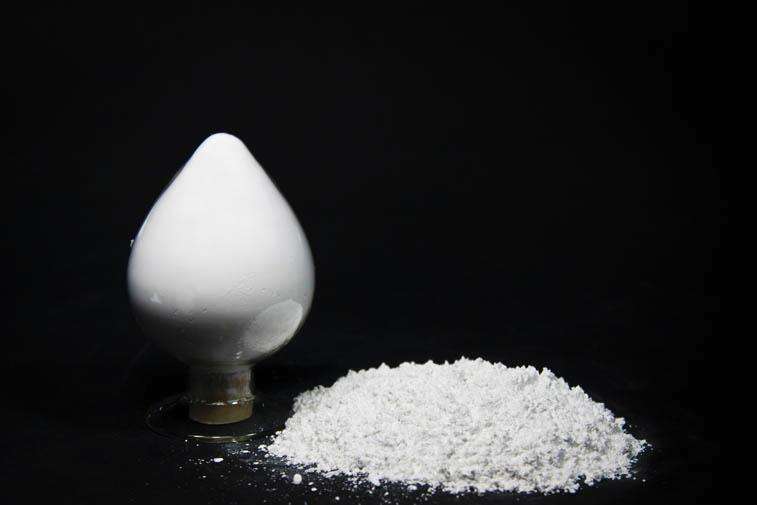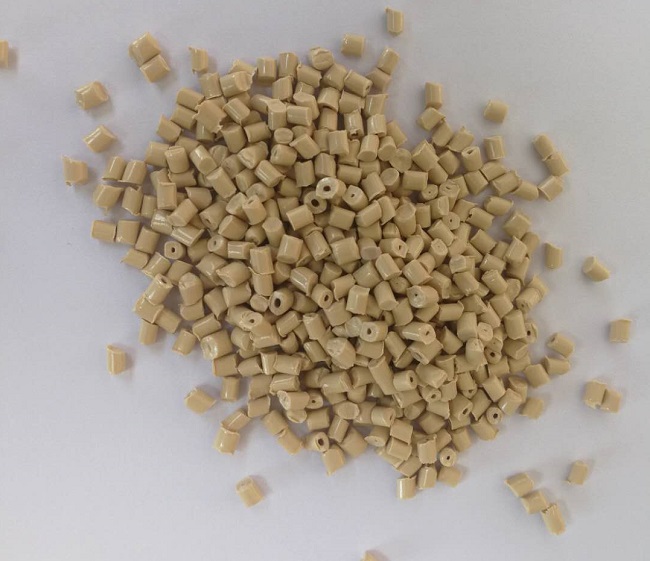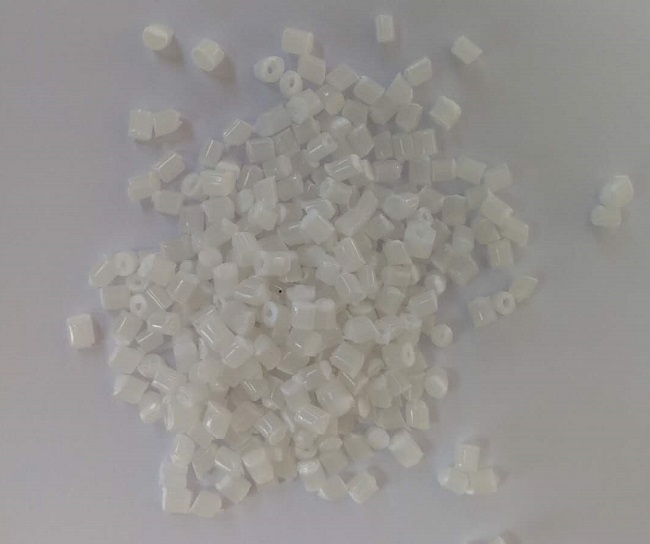
Antibacterial agents usually refers to a number of highly sensitive microorganisms, a small amount added to the material can significantly inhibit the growth of microorganisms on the surface of the material or chemical substances. By adding the additives, plastics and other materials under normal conditions of use, have a lasting ability to inhibit microbes such as bacteria, as antibacterial materials.
Most polymer materials are free from microbial attack without the aid of pure substances. However, when various additives are added, it is possible to breed, multiply and expand microorganisms, and the growth and multiplication of surface-attached bacteria will affect the appearance and performance of plastic products, and in particular, greatly reduce the safety of applications. Contamination of various items in contact with human health. Therefore, the development of plastic antibacterial function is extremely important and necessary. Currently the most common and effective way is to add antimicrobials.
First, the type of antibacterial agent
Antibacterial agents are usually divided into inorganic, organic, natural and polymer four categories. The company is located in:
Inorganic antibacterial agent
Inorganic antibacterial agent is used to contain antimicrobial metal load in a certain carrier, through ion exchange, adsorption, alloying or compounding.
Titanium antibacterial agents, mainly TiO2 such materials can be activated by the photocatalyst based. Currently nano-TiO2 as a highly effective antibacterial agent, has been used in sanitary ware, water treatment, antibacterial building materials and coatings and so on.
Silver antibacterial agents, the series of antibacterial agents is currently the most widely used varieties, according to different preparation techniques and carriers, silver antibacterial agents include the following major varieties: zeolite antibacterial agents, phosphate antibacterial agents, soluble glass Antibacterial agent, montmorillonite antibacterial agent and the like. Silver - activated carbon fiber antibacterial agent, silver activated carbon and active fiber antibacterial agent is mainly used for water purification.
Organic antibacterial agent
Although synthetic organic antibacterial agents have strong bactericidal power and abundant sources, they have the disadvantages of poor heat resistance, easy hydrolysis and strong pertinence, and have certain volatility and toxicity. At present, organic antibacterial agents in foreign markets are mostly organic nitrogen-containing ionic compounds, which are structurally similar to antistatic agents such as organic iodides, organic chlorides or their complexes, and amino acid metal salts.
Natural antibacterial agent
Natural antibacterial agent is refined from plants and animals refined, the focus is currently being developed ultrafine chitosan powder, chitin and so on. In addition, there are natural antibacterials such as albinism, glucosinolates and so on. But natural antibacterial agents due to its poor heat resistance, duration of efficacy is short, large-scale commercial time to wait.
Polymer antibacterial agent
Antimicrobial macromolecule materials are obtained by introducing antibacterial functional groups, which can be classified into quaternary ammonium salts, quaternary phosphonium salts, guanidinium salts, pyridine-type and organometallic copolymers according to different functional groups. The antibacterial functional groups can be obtained by reacting functional groups Homopolymer or copolymerization can also be introduced by grafting.
At present, there are quaternary ammonium antibacterial agents, quaternary phosphonium salt antibacterial agents and organotin antibacterial agents. Quaternary phosphonium salt is a new generation of antibacterial agent, its antimicrobial activity than the same structure quaternary ammonium salt two orders of magnitude, with broad spectrum, high efficiency, low toxicity and other advantages; containing organotin group antibacterial agent for Gram-positive bacteria , In particular very good at killing Staphylococcus aureus, but at a relatively low rate of killing of Gram-negative bacteria. In addition, containing pyridine polymer and halogenated amine polymer also has good antibacterial properties.
Second, antibacterial mechanism
Antibacterial material mechanism of action
The use of chemical and physical methods to kill or inhibit bacterial activity and growth and development of properties called antibacterial, kill bacteria or near sterile properties called sterilization, antibacterial generally customary including sterilization, sterilization, disinfection, antibacterial, anti-bacterial Mold, anti-corrosion and so on. Antibacterial or bactericidal materials known as antibacterial materials, antibacterial mechanism of action in the following areas:
(1) interfere with cell wall synthesis. Bacterial cell wall is an important component of peptidoglycan, antibacterial material on the cell wall interference, the main inhibition of the polysaccharide chain and polypeptide cross-linking, so that the cell wall loss of integrity, loss of the osmotic pressure of the protective effect, damage to cell death.
(2) damage the cell membrane. Cell membrane is an important part of bacterial cell life activities, so if the cell membrane damage, destruction, will lead to bacterial death.
(3) Inhibition of protein synthesis. The protein synthesis process changes, stop, resulting in bacterial death.
(4) interfere with the synthesis of nucleic acids. Generally speaking, hinder the replication of genetic information, including DNA, RNA synthesis, and DNA template transcription of mRNA.
Antibacterial agents antibacterial mechanism
Inorganic salts or complexes containing metal ions have the largest number of inorganic antibacterial species and have the most extensive application. The antibacterial mechanism is different for different antibacterial agents. The same antibacterial agent may even exhibit different antibacterial effects under different environmental conditions mechanism. At present, there is no authoritative conclusion about the antibacterial mechanism in academia. The representative doctrines are mainly metal ion dissolution theory and reactive oxygen species theory.
(1) metal ion dissolution antibacterial mechanism
Dissolution of metal ions theory that: in the use of antibacterial materials, antibacterial metal ions gradually dissolved from the antibacterial material, sustained release of Ag +, Cu2 +, Zn2 + ions firmly adsorbed and penetrate bacteria, mold cell wall, destruction of microbial electron transport system, Respiratory system, material transmission system, which quickly kill bacteria; into the cell body, but also with the bacterial hydroxyl reaction, the bacterial protein coagulation, destruction of bacterial cell activity of synthase, the cell loss of ability to divide and die and death. In the light of the role of the oxidation state of silver ions can become a catalytic activity center, activate water and oxygen in the air, have a strong oxidizing capacity of OH radicals and reactive oxygen species, destruction of bacteria in a short time the breeding Ability to cause bacterial death. When the bacteria lose their activity, the silver ions will be freed from the bacteria again and the bactericidal activity will be repeated.

Ruize JH02 polyolefin silver ion antibacterial masterbatch
The masterbatch is suitable for most polyolefins. The masterbatch can control the release rate of silver ions, prevent the growth of bacteria, molds and yeasts and has sufficient thermal stability. Therefore, it is suitable for most plastic processing.
(2) photocatalytic active groups antibacterial mechanism
When the light energy is greater than the forbidden band width, the valence band electrons are excited to transition to the conduction band, voids are generated on the valence band, and are separated and moved to the particle surface under the action of an electric field , Holes can seize the surface of the particles OH - and H2O in the electron, its oxidation into a strong oxidizing · OH group. · OH can make the vast majority of bacteria, organic pollutants eventually decomposed into CO2, H2O and other harmful small molecules. Nano-TiO2 photocatalytic antibacterial, not only can effectively kill bacteria, but also attack the outer layer of bacterial cells and destroy the cell membrane structure, to completely degrade bacteria, and can eradicate endotoxin-induced secondary pollution.
Third, the choice of plastic antibacterial agent
Antibacterial agents in the actual use of plastic, plastic antibacterial, physical properties, uses and processing methods and many other requirements, combined with the anti-bacterial agents of the physical and chemical indicators, comprehensive consideration and choice. The main factors to consider are:
Antibacterial effect
The antibacterial effect is mainly reflected by the I C value (the minimum concentration of the antibacterial agent that impedes the propagation of bacteria). The smaller the I C value, the better the antibacterial effect. Antibacterial materials with antibacterial agents, the antibacterial capacity is mainly dependent on the surface of the antibacterial agent to achieve, therefore, the amount added is generally higher than its I C value. In addition, but also antibacterial persistence, antibacterial plastic to maintain long-term anti-bacterial.
Antibacterial range
Different antibacterial agents have different antibacterial ability to different bacteria, that is to say, the antibacterial agents only show the antibacterial activity to the specific bacteria. In selecting the antibacterial agent, the antibacterial agent's antibacterial range should be considered. The antibacterial range is of course as wide as possible. However, when it is not reached, several different antibacterial agents can be used in combination to achieve the desired antibacterial range, but attention should be paid to the synergies of various antibacterial agents.
safety
As food packaging materials, the choice of antimicrobial agents must be harmless to the human body, should avoid the use of acute toxicity, chronic toxicity, odor, skin irritation and other antimicrobial agents. Therefore, the use of organic antimicrobial agents has great limitations, and inorganic antimicrobial agents and natural antimicrobial agents due to their safety become the hot spot in this area.
compatibility
The selected antibacterial agent must have good compatibility and compatibility with the plastic, will not adversely affect the performance of plastic products.
stability
Antibacterial agent should have high thermal stability, in the plastic extrusion and processing process does not decompose, no deterioration, to maintain antibacterial efficacy; the same time, good antibacterial color stability, preservation and use of the process does not change color; also have a good Chemical stability, acid, alkali and chemicals.
price
Antibacterial agents should be cheaper prices, after use will not significantly increase the cost of materials.
Fourth, the application of plastic antibacterial agent
Different antibacterial products, different methods can be used to add antibacterial agents. Of course, the added effect is different.
Production of plastic antibacterial products, antibacterial agents, antibacterial masterbatch, antibacterial plastic to produce. Direct addition of antibacterial agent process is simple, but the antibacterial agent is poorly dispersed in plastic, antibacterial agent particles easily dispersed, antibacterial effect is poor, antibacterial agent is not fully utilized, the use of increased costs. Antibacterial masterbatch France's core technology is the development of antibacterial masterbatch. Antibacterial masterbatch is a highly concentrated antibacterial agent dispersed in the carrier resin containing antimicrobial doses of 10% to 40%. Antibacterial masterbatch processed together with plastic, or blended again with the plastic dispersion is conducive to the dispersion of antibacterial agents and antibacterial effect, is now widely accepted and widely used technology approach. Because the direct use of antibacterial agents can affect the appearance of plastic products, resulting in reduced antibacterial efficiency, while the use of antimicrobial plastic production costs are high, so both methods have been in the international backward state. At present, the international use of antibacterial masterbatch to increase the production of antibacterial plastic products.

Ruize JH02S anti-yellowing polyolefin antibacterial masterbatch
The antibacterial agent made masterbatch, heat resistance, good dispersion, good filtration performance, good antibacterial effect, long-lasting high, resistant to washing. The antibacterial masterbatch is widely used in plastic products, chemical fiber, non-woven fabrics, etc., can make their products have long-term antimicrobial, has become indispensable to daily life necessities.
For the manufacture of injection-type antibacterial plastic, the specific implementation of the general there are two, one is the ultra-fine antibacterial agent particles sprayed liquid spray on the plastic mold surface, the plastic injection molding antibacterial agent into the plastic surface ; The other is the antibacterial agent made of plastic and film, and then the film attached to the mold surface, plastic molding in the anti-bacterial plastic film bonded to the workpiece surface. The use of this antibacterial molding technology can greatly save the amount of antibacterial agent, but the application is not common, mainly due to large equipment investment.
Plastic is an indispensable material in people's daily life and industrial products, has a wide range of applications. The use of antibacterial plastic can improve product hygiene, reduce the pollution of pathogens. At present, there are many varieties of antibacterial plastic produced by using antibacterial agents, covering a wide range of fields.
In addition, the structure and status of the antibacterial agent itself is the most important factor that determines and affects the antibacterial properties. Antibacterial agents in the plastic matrix dispersion, microbial aggregation state, the specific circumstances of the application of plastic products, antibacterial properties of antibacterial plastics have a significant impact. Therefore, material design should be considered.
Fifth, the other role of plastic antibacterial agent
Adding antibacterial agents to plastics can sometimes reduce the odors they emit, delaying aging, discoloration and embrittlement on the surface.
During processing, the more polar antibacterial functional groups are easily distributed on the surface, on the one hand, the effective utilization of the antibacterial functional groups is increased, on the other hand, the surface polarity and hydrophilicity are improved, thereby improving the antistatic properties of the product performance. For example, antibacterial masterbatch can make the hydrophilic surface of polypropylene fiber reach the level of nylon fiber, the surface resistivity can be reduced by 5-6 orders of magnitude, which greatly improves the material processing and use performance.
Antimicrobial nano-TiO2 has been shown to have a good ability to decompose this gas for the odor of household appliances, especially refrigerators. In the sealed state, the fluorescent lamp is used to provide the light source, the sealed water outlet of the refrigerating and defrosting is sealed, the odor gas formaldehyde is introduced into the refrigerating chamber, So that the concentration reached 30ppm, 24 hours after the test, the degradation rate of formaldehyde up to 90%, which proved that adding nano-TiO2 home appliances plastic products, also has a good ability to decompose odor gases. For practical use of household appliances, the concentration of odor gas is very low around the room light or light inside the appliance is generally weak, and this is sufficient to meet the nano-TiO2 plastic products, the removal of trace odor gas decomposition requirements.
Six, plastic antibacterial agent evaluation criteria
Authoritative technical standards are the key to the healthy development of antibacterial materials themselves. Internationally, materials are treated with antibacterial technology. Japan is the most widely used material. In the mid-90s of last century, Japan Anti-Bacterial Technology Association (SIAA) formulated "Antimicrobial products-Test method for antibacterial activity and antibacterial rate for antimicrobial activity and efficacy "and became Japan's national industry standard JIS Z 2801 in 2000. Our country was promulgated in September 2003 by the National Development and Reform Commission (QB / T 2591-2003 "Antibacterial Plastics - Test Method for Antibacterial Properties and Antibacterial Effect"). The standard method in the basic adoption of the Japanese JIS Z 2801 standard.
This standard gives a quantitative test method for the determination of antimicrobial plastic antibacterial. It reflects the antibacterial plastic contact antibacterial principle, and in the experimental design to consider the actual use of antibacterial plastic and other external factors, can more objectively reflect the antibacterial plastic antibacterial capacity. Antibiotic standard antibacterial rate of more than 90% of qualified products, judged to have antibacterial; more than 99% for strong antibacterial.
The standard mold level is divided into 0,1,2,3,4 level. The highest level of anti-mildew grade 0 is not long, the microscope 50 times magnification did not observe the growth of mold; 1 is a trace of growth, the growth area can be seen less than 10%; 2, 3, 4 were mild growth, moderate Growth and serious growth. Anti-bacterial plastic mold rating of 1, can be reported to have anti-fungal effect, 0 can report a strong anti-fungal effect.
Seven, plastic antimicrobial latest research progress and direction
At present, the development and antibacterial processing technology of new inorganic antimicrobial agents in foreign countries have progressed rapidly. So far, a series of products have been formed and have been developed towards high performance and compounding. The main progress and direction in the following aspects.
Photocatalyst type antibacterial agent
Photocatalyst antibacterial agents have been used more and more widely since they were first introduced in Japan in 1995, such as ceramic materials with photocatalyst coatings and air purifiers with photocatalyst as the core. However, the application of photocatalytic antibacterial agent in plastics still needs to solve its aging problem of polymer resins.
Anionic antibacterial agent
Anion materials is a class of functional materials that can automatically release negative ions in a certain environment. The material has a permanent self-generating polarity. In the electric field generated by the electrodes, the multiplication of the microorganisms under the micro-current can be significantly suppressed or even killed Off, so negative ion material has antibacterial / anti-bacterial function. At present, antibacterial plastic and antibacterial paint are prepared by the negative ion type antibacterial agent, and have been tentatively used in the water treatment and the enclosed space in the interior, the car and the refrigerator.
Polymer antibacterial agent
According to the antibacterial mechanism of organic antibacterial agents and natural polymeric antibacterial agents, the molecular design is combined with the characteristics of organic antibacterial agents and natural polymeric antibacterial agents to synthesize macromolecules with antibacterial properties. Synthetic polymeric antibacterial agents can overcome the shortcomings of poor heat resistance of natural antibacterial agents, and can directly obtain new antibacterial materials with different mechanical properties and biological properties through synthesis.
Study on Color Stabilization of Silver Antibacterial Agents
The traditional silver antibacterial agent is the most common inorganic antibacterial agent. However, the silver ions are easy to restore and change color under the action of light, heat and the like, and the problem of discoloration severely restricts the application range and becomes one of the problems in the application field of the antibacterial agent. At present, there are two main ways to solve this problem: (1) The structure of antibacterial agent is adjusted by controlling the processing technology. However, the burning may cause the antibacterial properties of some antibacterial agents to decline. (2) use the process of adding color change inhibitor. At present, there are two major types of discoloration inhibitors for silver antibacterial agents of practical value, one is used in combination with fiber finishing agents and the other is used in plastics to inhibit the discoloration of silver antibacterial agents in plastics. The combination of fiber finishing agent used in silver antibacterial agent discoloration inhibitors are generally benzotriazole compounds, the main products of methylbenzotriazole and methylbenzotriazole potassium, plastic commonly used in the main color inhibitor of natural Hydrotalcite [Mg6Al2 (HO) 16CO3.4H2O], synthetic hydrotalcite [Mg4,5Al2 (OH) 13CO3.3.5H2O] and its calcined product (Mg0.7Al0.3O1.15), and basic zinc carbonate and zirconium phosphate Wait. These discoloration inhibitors have been applied to certain antimicrobial plastic products, and played a role.
Antibacterial agent complex
No single antimicrobial agent can be completely adapted to all applications, and in practice, often need to compound a variety of antimicrobial agents. In order to make full use of the advantages of various antibacterial agents, the complex antibacterial agents need to produce synergistic effects. The synergistic effect of antibacterial agents is embodied in that the antibacterial agent can be effectively used for an extended period of time, and antibacterial properties can be produced when the overall concentration is low, and the antibacterial spectrum of the antibacterial agent can be broadened.
Antimicrobials Structured
The structure of antibacterial agents play an important role in the antibacterial performance of antibacterial agents, the affinity of antibacterial agents and matrix materials, the use of antibacterial agents on the physical properties, mechanical properties and optical properties of the materials. Therefore, the antibacterial agent structure design can obviously Improve the using efficiency of the antibacterial agent, improve the performance of antibacterial materials and antibacterial products using the antibacterial agent, form personalized antibacterial products in different fields, and can greatly expand the application fields of the antibacterial agent.
Eight, conclusion
Plastic antibacterial agents and antibacterial materials research, is an emerging discipline in the world, so many mechanisms and principles of action yet to be further studied, but at the same time there are new advent of antibacterial agents used in plastics. To be sure, as people's living standards continue to improve, environmental protection, health awareness, antibacterial plastic will be more and more people's attention and welcome, with broad prospects for development. In short, we should pay more attention to plastic antibacterial agents and antibacterial plastic, develop more new varieties of plastic antibacterial agents, and expand their application fields so that they can better serve human beings.
Ruize professional production of antibacterial masterbatch
Good quality, good antibacterial performance
For you to create a healthier living environment!

Yancheng Ruize Masterbatch Co., Ltd. mainly produces and operates: antibacterial masterbatch, Non-woven antibacterial masterbatch,antistatic masterbatch, polypropylene filament masterbatch, polyester short wire masterbatch , Polypropylene filament masterbatch, Non-woven antibacterial masterbatch, polypropylene spunbond non-woven masterbatch, Polypropylene fiber masterbatch, chemical masterbatch, Non-woven antibacterial masterbatch, polypropylene masterbatch, Soft hydrophilic masterbatch.
- Mizlion made a stunning appearan
- Why is it said that polypropylen
- The impact of the Federal Reserv
- Chemical fibers "carry static el
- What are the core considerations
- The High Performance and High Fu
- At the end of the year, a new ch
- Exhibition Invitation: Ruize Mas
- Ruize Masterbatch congratulates

